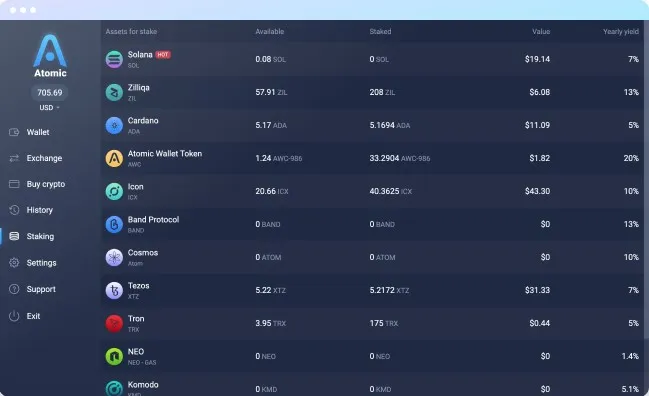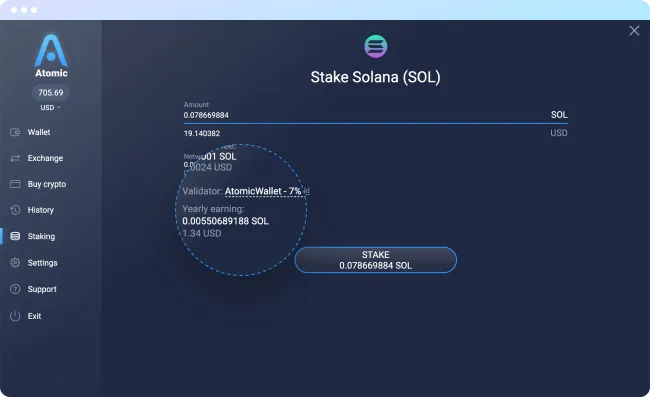Secure Crypto Staking
Stake your Crypto and earn passive income up to 20% yearly
Ethereum
ROI ~5%Solana
ROI ~7%Cardano
ROI ~3.06%BNB
ROI ~2.5%Polygon
ROI ~4.2%Tron
ROI ~5%Cosmos
ROI ~16.14%Hedera
ROI ~0.7%Kava
ROI ~6.61%Near
ROI ~7.41%Zilliqa
ROI ~12%Band Protocol
ROI ~12.69%MultiversX
ROI ~7.49%Osmosis
ROI ~5.58%Atomic Wallet Token
ROI ~20%Terra Classic
ROI ~12%Terra LUNA
ROI ~7%Flare
ROI ~4.2%ICON
ROI ~10%Algorand
ROI ~0.63%Tezos
ROI ~5.8%Komodo
ROI ~5.1%VeChain
ROI ~1.63%Injective
ROI ~17%Cronos
ROI ~5.54%Akash Network
ROI ~14%Nibiru Chain
ROI ~29.70%LAVA
ROI ~156%Artificial Superintelligence Alliance
ROI ~9.5%BABY
ROI ~27.09%Monad
ROI ~15%How Staking Works
You Stake Crypto
Stake your crypto in the Atomic Wallet appValidator creates blocks
Receive regular staking rewards while supporting the blockchainReceive Profit
Rewards will be transferred to your wallet automatically. For some coins, you will need to claim rewards manually.Why stake crypto with Atomic Wallet?

Lots of crypto to choose
20+ assets available for staking, 30+ blockchains supported, tons of tokens can be managed in the app.

Simple yet powerful interface
Your crypto, your decisions: Choose any validator and unstake whenever you want. Manage, buy, swap, and stake your crypto in one app

Your crypto is safe
You're the only person in full control of your private keys and crypto
What you can stake
What you can get
Staking guides
If you're just starting out
24/7 live support
Our support team is always here to help you
Regular app updates
We keep our app up to date with blockchain updates to provide you with a seamless staking experience
Own staking ecosystem
We provide our own validators to bring you both comfortable and profitable staking experience
What is Staking
Every cryptocurrency transaction should be verified – that’s how blockchain works. To verify transactions, a blockchain network uses a consensus mechanism. In short, this mechanism guarantees that all the network nodes agree about the validity of a certain data point. This process guarantees transaction is proceeding without any false data. The two most popular mechanisms are Proof of Work and Proof of Stake.
What is Proof of work?
This traditional approach, Proof of work, requires a node to validate transactions by approving them and adding them to a new block on the blockchain. A node to validate transactions is chosen based on its computational power. This is what gave rise to crypto mining as an industry. This consensus mechanism is used in such coins as Bitcoin and, up until very recently, Ethereum. While Bitcoin remains loyal to its original consensus mechanism, Ethereum network recently switched to another consensus mechanism - Proof of Stake.
What is Proof of Stake?
Proof of Stake (PoS) is a consensus mechanism, where the network chooses validators to add new blocks to the blockchain. A computational power of a node is not taken into account. The process is random, but the bigger the stake (i.e. the number of cryptocurrency users have staked with a particular validator) the more likely the validator is to be the one to add new blocks to the blockchain. In swap for adding the new block, the validator earns some crypto, which they, in turn, distribute among those who staked their assets with them.
How does crypto staking work?
While the exact details vary from one asset to another, the general principles of crypto staking remain the same. In short, the staking process is the process of putting money on the line for a chance to add a new block to the blockchain which in turn means better staking rewards. Your cryptocurrency serves as a guarantee, that any new transaction that is being added to the blockchain is legitimate.
Why stake my crypto holdings?
With the increase in crypto mining difficulty, staking became more and more attractive for cryptocurrency investors.
With staking, your assets don't just take up space on the blockchain, they are actively used to add new blocks to the blockchain. You can stake your coins and earn rewards for validating transactions or, in other words, earn passive income for holding funds. By staking your funds with a specific validator or staking pool, you increase their chances of being chosen and, by extension, your chances of getting better rewards. As mentioned above, the bigger the stake, the more of a chance a validator has of adding a new block to the blockchain.
The process is still random, however, so it doesn't mean that everyone should just stake their funds with the same staking pool. While smaller staking pools are less likely to be chosen to validate the new blocks, the rewards are going to be much higher, since there aren't as many investors among which the rewards shall be distributed.
If you choose to stake your assets in Atomic Wallet, you'll be pleased to find out that we are running our own staking pools for certain cryptocurrencies, like Cardano.
How do I get my staking rewards?
Here, the process really differs from asset to asset. While staking Solana, for example, the rewards are automatically added to your staked amount, providing compound interest, similar to what you may find in a bank.
With other cryptos, like Cosmos, rewards accumulate and you have to manually claim them in order to transfer them to your address. Such claiming transactions always require network fees to be paid, so keep that in mind when staking your funds.
Is staking just about passive income?
Earning rewards is not the only thing staking crypto is used for. After all, it's not just a savings account in your local bank. Staking rewards do provide a great incentive for crypto users, true, but there are certain cryptocurrencies, that also allow users to vote and participate in the governance of the blockchain network. For example Icon or Tron.
APY of your staked assets
APY, of Annual Percentage Yield, is the estimated percentage of annual return on your staking investment. In other words, the amount of money, or interest, you earn on a certain staked asset over one year.
APY can help you understand if staking a certain asset is a good investment for you or not. Using the APY you can get a rough idea of how much staking rewards you're going to get over a certain period of time.
Beginner crypto investors should keep in mind, however, that APY of crypto assets is constantly fluctuating. APY is an approximate number and it may change several times during the staking period of your asset.
In Atomic Wallet, for instance, assets with the highest APY are Atomic Wallet Coin and Zilliqa.
Crypto staking sounds perfect
At first glance, it does look like there are no downsides to staking. Earning interest in a form of cryptocurrency while doing nothing, watching your digital assets grow.
Staking, however, does have its rules that some users may find too limiting.
Minimum lock-up period
Some crypto assets get locked during the staking period. In other words, staked assets cannot be sent out or exchanged right away. NEAR protocol is one example of such assets.
Long-term investors, who have no problem staking coins for long periods of time will probably not care about this, while more trade-oriented users, who like to capitalize on price swings will certainly find this inability to swap coins any time they want very inconvenient.
Unstaking period
With many cryptocurrencies, unstaking does not happen immediately and the network is locking your assets for the entire duration of the unstaking period. Unstaking period duration may vary from about 4 days with the aforementioned NEAR to up to 21 days with BAND. A long unstaking period which makes it impossible to withdraw or swap your tokens and coins in the event of a price swing makes staking unappealing to certain users.
Transaction fees
Staking crypto involves making a certain amount of transactions on the blockchain. The exact number depends on the cryptocurrency itself. Quite often users will stake all of their coins and then not have enough left to unstake or claim their rewards.
Staking ZIL, for example, requires a transaction to stake your coins, claim rewards, unstake, and then transfer the funds to your address. While the fees on Proof of Stake networks are usually quite low, the sheer number of things you have to do might be off-putting.
How do I start staking?
Crypto staking is a simple process overall. First, you need to pick an asset that you'd like to stake.
See when you get your first staking rewards
With some assets, like Tezos, it might take up to 40 days after staking to see your interest. While with others, such as VeChain you'll start seeing passive income just 40 seconds after staking.
Look at how often you get your rewards
If you're planning on staking large amounts of crypto and generating huge interest, then it might be a good idea to look into blockchain networks with the most frequent reward payouts. TRX, for instance, allows you to claim your rewards every day.
If you're not planning on claiming your rewards regularly and prefer to claim them occasionally, staking pretty much any crypto would fit you.
Look at the APY of an asset
Most users get into crypto staking to earn passive income, so gauging how many rewards you're going to get over a certain period of time makes sense.
Don't let it be your deciding factor, however. VeChain can't boast a massive APY, but its ease of use may be exactly what you're looking for.
See if an asset has a locking period
If you like watching the candlestick chart and getting the most profitable crypto swap possible, an asset that doesn't lock your funds may be the best bet for you. The way ADA staking works might be of interest to such trade-oriented users.
Otherwise, if you just want to stake cryptocurrency and forget about it for several months, then even the longest locking periods, like those of BAND or ATOM should not deter you.
You can research each coin individually online or you can check out our guide and get all the crypto-staking tips you might need in one place!
Summarizing crypto staking
The proof of Stake consensus method insures the security and stability of the blockchain while allowing holders of the coin to earn interest, providing an alternative to mining crypto. By staking your crypto, you help keep the blockchain going and earn rewards.
Pick a coin or a token that suits you best and jump right into the world of staking, where your cryptocurrency does the work for you.











